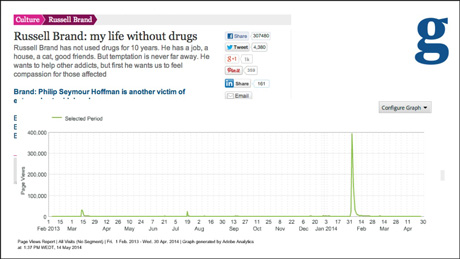
The Guardian looks to sites such as BuzzFeed and Vice to understand more about what makes content highly shareable, Laura Oliver, the outlet's social and community editor, UK, said at the London Social Media Summit.
"We take these guys very seriously," Oliver said, speaking at the event on Friday (16 May) organised by the BBC College of Journalism and the New York Times.
"We look at ways that we can learn from them [in terms of] formats, headlines, the type of content, how it's built, how shareable is it and what's going to make people share it."
However, Oliver stressed to Journalism.co.uk that although the outlet does evaluate its own content and others, it would "remain true to the Guardian's journalism".
She added that the Guardian also spends "a lot of time" looking at their own stories which have gone viral, and what factors may have contributed to their popularity.
Although she noted that "there's often a lot of things we can't control," she said there were three key factors that the Guardian had identified in content that was well-shared, both on social networks and other off-site sources.
1. TImelessness
If a story contains themes and issues which do not have a limited shelf-life, the potential for that story to continue to be shared, indefinitely, it much greater.
Oliver cited the Guardian article Top 5 regrets of the dying which, despite being published in February 2012, is "frequently still popping up in [the Guardian's] most read lists".
"That's because someone discovers it, they email it, they share it on Facebook with someone in their friendship group who hasn't read it yet, and it's a really timeless piece of content and a really good read."
In a nod to BuzzFeed, Oliver noted that it was "interesting" that the article was also a list. BuzzFeed has become synonymous with the 'listicle' format.
In a keynote speech at the news:rewired conference in February, Jack Shepherd, BuzzFeed's editorial director, noted that lists were so popular because they were "easy to scan, you're not messing with people's expectations, people know exactly what they're going to get".
However, Oliver added that its main appeal was that it was "just a really personal, human interest, thoughtful, considered piece".
"It crops up probably around once a fortnight in our "most read" [stories], it just comes back round again."
2. Packaging
The way that content is packaged in terms of what format is used and what multimedia elements are included can also have an impact on how shareable a story is.
Older stories can also enjoy a flood of interest if they are relevant to news that is current or breaking, noted Oliver.
As an example, she pointed to a piece written by Russell Brand in 2013 entitled My life without drugs, which received a "surge of traffic" when Philip Seymour-Hoffman passed away of a suspected heroin overdose in February 2014.
"It was picked up organically through Facebook and people started sharing it again," Oliver said.
The chart below shows the traffic to Brand's piece when it was initially published in 2013, and the huge spike in page views around the time of Seymour-Hoffman's death.

A slife from Laura Oliver's presentation on shareable content from the London Social Media Summit.
As a result, the Guardian commissioned a separate piece from Brand on Seymour-Hoffman's death, and linked Brand's original story to the later piece in a way that was designed to optimise traffic to both.
Quizzes are another way to cover heavier stories that might otherwise be seen as "dry", said Oliver, such as the introduction of a new UK citizenship test in March.
3. Knowing your audience
Sometimes, Oliver said, a well-shared story is simply down to "a very Guardian headline".
Can vegans stomach the truth about quinoa? received 1.1 million page views when it was published in January 2013, with around half of that traffic coming from social.
However, Oliver noted that the success of humorous articles like this are not necessarily going to change the type of stories the Guardian commissions.
Encouraging users to submit their own content to your platform, as GuardianWitness does, is another way of increasing shareability by making audiences feel more engaged in the news-making process, she added.
She advised journalists to "think about what motivates people to share content with your news outlet, and with their own networks".
However, she admitted that the Guardian did not always get this right, pointing to a GuardianWitness 'assignment' launched in April inviting voters in India to share images of their ink-stained fingertips, which received only seven contributions.
In this case the Guardian had "over-estimated" the size of its "participating audience" in India, said Oliver.
The Guardian's Ophan analytics platform, developed in-house, had also allowed journalists to understand what kind of content is being shared by their audience and by what method.
"You can see the top five ways that people are essentially sharing content, and even the headlines they're writing to share it," said Oliver.
"It's not just about the top 10 [most read] stories any more."
Update: This article was updated to clarify Oliver's point with regards to the nature of the Guardian's audience in India.
Free daily newsletter
If you like our news and feature articles, you can sign up to receive our free daily (Mon-Fri) email newsletter (mobile friendly).
Related articles
- Futureproofing your newsroom: understand your USP in a crowded space
- DCMS-backed media literacy programme is supporting vulnerable internet users
- Tip: Lessons from the Guardian's membership model
- How should the media cover COP26 and climate change long-term?
- Samantha Tomaszewski, social strategy leader, BuzzFeed, on career in social media audience engagement











